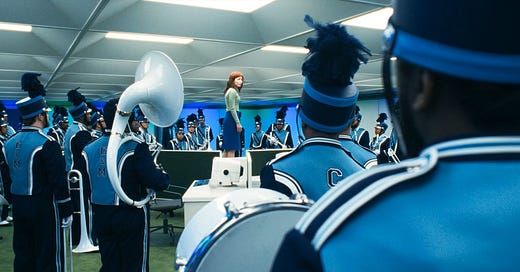For the past several months, our struggle – existential and material, though mostly existential insofar as it is material – has been not to assert our place, but to understand it. How can we fight for a place if can’t grasp its shape and boundaries, if we can’t cobble together a few predicted outcomes to resist or fight for?
It’s not just that we have trouble imagining a future. Lately, we also seem to lack more than a tenuous grasp on the present. These are cruel, vicious times. Some seem to gleefully relish dropping the floor out from under us. And/or making us feel like it might at any moment.
Turning to popular culture for any explanation is frequently, often correctly, dismissed as a fool's errand, a soft option compared to understanding the world as it actually is. That our favorite shows and a rotating selection of movies seem to be the only stable constants in our lives merely cements their status as spectacle.
This is only one side of the dialectical coin. The political unconscious doesn’t work solely in favor of subjugation. We are creatures of contradiction, of strange desires whose excess can’t always be captured. Crafting a compelling story frequently demands that we regard these healthier, more liberatory impulses (even if the culture industry does ultimately capture them).
Take, for example, the season two finale of Severance. This is a show whose second season could have easily run aground, not despite the originality of its premise, but because of it. Making literal the division between our “work selves” and our “real” selves (our innies and our outies) is a clever and relatable conceit, but could easily become limiting. What to do with the premise? How to ensure the plot remained thematically coherent and didn’t resort to easy gimmicks?
The second season answered those questions. It showed us more corners of the severed floor, stranger parts of an existence designed to be smooth and unthreatening. It built on the Lumon corporation’s cult-like history and neo-Victorian practices, far-flung into frozen wilderness preserves and abandoned mill towns.
Think of the season finale’s Hitchcockian final shots. Innie Mark and innie Helly running back into the severed floor’s windowless depths, Mark’s outie wife Gemma frantically screaming for him on the other side of a locked door, all to the eerie-longing tune of Mel Tormé’s version of “The Windmills of Your Mind.”
It’s a perfect ending, honestly good enough to finish the series with. Particularly juxtaposed with the weirdest scene of the season, rivaled in the show only by season one’s waffle party. The completion of the Cold Harbor project celebrated with… a marching band. Milchick, the quintessential manager — disillusioned and resentful, who can only direct his bitterness with his boss against his subordinates — dancing, stone-faced and menacing. I can remember who I am and how I am being used his moves say. What’s your excuse?
What starts as Mark, Helly, and Dylan barricading Milchick in the bathroom turns into a small-scale insurrection on the part of the (also-severed) marching band. Standing on the desks, Helly speaks: “They give us half a life, and think we won’t fight for it.” So they turn in Milchick’s direction, a room full of severed employees against one unsevered manager. They haven’t a clue who they are, or even what their last names are. They just know that unless they push back, they’ve already vanished.
Inside is all they know. White walls, functional furniture, creepy art, a marching band, goats. It’s all numbers, set like a watch within certain limits and times. Nothing gets better, but at least you can expect it won’t get worse. But then it does, increasingly so. People you love – as unsure of who they are as you – disappear without warning. Attempts to find the truth are thwarted with the cool, dispassionate touch of the bureaucrat.
The growing awareness that it’s bound to happen to you too. The lies pile up. You know that fighting for yourself means in some way preserving this hell, but what other choice do you have if you want to live?
Outside is the real. Not “reality,” but the real: existence outside the tightly controlled fantasy. The place where people die violent deaths, where towns rot in the cold ether. It’s where you finally face yourself, where the real work of building a life begins, sans guardrails. No wonder our instinct is to run from it.
So which half do you fight for?
Header image is from “Cold Harbor,” season two finale of Severance.



